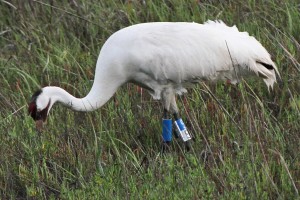by Chester McConnell, Whooping Crane Conservation Association
Whooping crane nesting success on Wood Buffalo National Park, Canada during 2012 was considered good but slightly down from previous years. This is good news after the poor winter season on Aransas National Wildlife Refuge in Texas.
Sixty six (66) whooping crane nests were discovered in May by the CanadianWildlife Service. Three months later in August, an additional three (3) family groups were identified indicating that there were at least sixty-nine (69) nesting attempts during the2012 nesting season. In early August, just prior to fledging, thirty-four (34) young were observed on the breeding grounds. Two (2) sets of twins were observed. Ten of the young whooping cranes were marked with leg bands and satellite transmitters.
Martha Tacha, U.S. Fish and Wildlife Service reports that: “The whooping cranes began moving down into staging areas in Saskatchewan last month; a week ago about half of the GPS-marked cranes were in Saskatchewan. There are currently 30 whooping cranes carrying working GPS transmitters, and likely a hand-full of marked cranes with colored leg bands from 1978 to 1988 marking effort. As of this morning (Oct.5), there were no GPS-marked cranes in the United States except for one young whooper in Burke County, in extreme northwest North Dakota (this bird was also observed independently by biologists on the ground on and after September 22, 2012). However, I have also received confirmed, probable, and several unconfirmed reports of whooping cranes observed as far south as southcentral North Dakota, so apparently at least one or two whooping cranes without GPS transmitters have moved farther into the northern reaches of the U.S. Flyway.” Citizen birders have also reported to the Whooping Crane Conservation Association of their observation of whooping cranes in Saskatchewan and North Dakota.
The Whooping Crane Conservation Association is hopeful for a much better winter season on Aransas Refuge. As most whooping crane interests know, last winter on the refuge was abnormal in several respects, including severe drought conditions and poor food availability. Some of the cranes spent some or all of the winter away from Aransas making accurate counts of the birds impossible. During the past several months, the Aransas area has received more rain and habitat conditions are improved. Blue crab numbers have rebounded along the Aransas Refuge coast and the returning whooping cranes will, at least, start out with a good food supply. Hopefully the wolfberry crop will improve and be another source of food.
The retirement of Tom Stehn last year resulted in a change from a direct count method to a transect-based survey of the greater Aransas NWR area to estimate the number of whooping cranes wintering there. Therefore, the official estimate of 254 whooping cranes wintering at Aransas last winter is not comparable to previous years’ estimates of flock size. There was much optimism that a record three hundred (300) whoopers would be counted on Aransas Refuge in 2012, but due to the unusual movements of the cranes and the new census method, the accurate number will never be known. Hopefully, this winter will be more typical in terms of crane distribution and Aransas Refuge biologists will be successful in making an accurate count.


